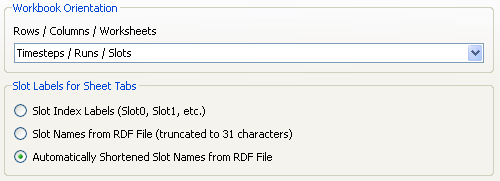RdfToExcel Plugin Help Information
Table
Of Contents
Overview
The
RdfToExcel plugin will use a RiverWare Data Format (RDF) file and
convert its contents into an Excel workbook using user-specified
configuration options. This is accomplished, in part, by automating
Excel on the user's computer, so the tool is Windows only, and the user
must have Excel. installed. Since the tool automates whatever version
of Excel the user has installed, the tool is not tied any particular
version of Excel and its associated workbook format or limitations.
RDF
Files
RDF
files are generated from RiverWare and contain data for slots specified
by the user. Non-series slots can be written to RDF files, but only
data for series slots will be processed by the RdfToExcel tool for
writing to Excel. The exact format of an RDF file is described in the
Output and Plotting section of RiverWare Online Help. An RDF file for
results from a single run in RiverWare can be created from the Output
Manager via a RiverWare Data File device. Slot data for a
multiple
run in RiverWare can be output to an RDF file by configurations
in the Output tab of the MRM Configuration dialog.
Excel
Workbook
When
an RDF file is written to an Excel workbook, a Header worksheet is
created followed by sheets containing the slot data. These are
discussed
below along with the available slot name options.
Header
Sheet
The
header sheet contains a summary of
the information in the RDF file that is not slot
data. This includes:
File name
Owner
Description
Creation Date
Number of Runs
Number of Slots
Number of Timesteps
Information for Each Run
Information for Each Slot
Listing of the Timestep Dates
Data
Sheets
The
appearance of the data sheets depends on the workbook orientation
option selected by the user. A workbook has three "dimensions", rows,
columns, and worksheets, that can be mapped to the data dimensions of
timesteps, slots, and runs. Typical orientations would be to put
timesteps as rows, slots as columns, and runs as sheets, or timesteps
as rows, runs as columns, and slots as sheets. In this last
orientation, for example, the first column would contain a timestep
label in each row, the first row would contain a run label in
each column, each sheet would be labeled as a slot, and cells
in
the sheets would contain the corresponding timestep data as
indicated by the header labels and sheet name.Some orientations are
more common, but any of the six possible orientations are available.
Slot
Names
Because
slot names from RiverWare can be very long, fitting them into the
workbook can be problematic, most notably in the case
where they
are sheet tab labels, which are limited to 31 characters. For this
reason, the tool provides three options for writing slot names to the
workbook:
Slot Index Labels
Full Slot Name (truncated if necessary)
Automatically Shortened Slot Names
Slot
index labels are Slot0, Slot1, Slot2, etc. The index names are mapped
to the actual slot names on the Header sheet, but the index labels are
used in the data sheets.
The full slot names are the
object and slot name concatenated. If these are used on sheet tabs,
colons are removed because these are not legal characters on tabs.
Since the number of characters on tabs is limited to 31, the
name
is truncated to 30 characters to fit, if necessary, and a '~' is
appended to the end to show it is truncated.. If this truncating does
not make the name unique with respect to other slot names, a sequential
number is prepended to the name to make it unique. Note that
the
full object slot name is placed into the first cell (A1) of the sheet
so the actual slot can be easily determined..
Automatically shortened slot names are shortened according to the
following criteria:
"And" in the name is
replace with "&"
Colons and spaces are removed
All lower case vowels are removed
As
an example, PowellStorage becomes PwllStrg. If the shortened name is
used on sheet tabs and it still exceeds 31 characters, it is truncated
to 30 characters and a '~' is added to the end to indicate the name is
shortened. If the truncated name is not unique with respect to other
slot names, a sequential number is prepended to the name to
make
it unique. The full object slot name is placed into the first cell (A1)
of the sheet so the actual slot can be easily determined.
User
Interface
When the RdfToExcel plugin is activated, the following user interface
is presented (note that the source RDF file and the result workbook are
configured in the program calling the plugin, so are not part of this
interface):

The Workbook Orientation
frame of the dialog provides a combo box with choices of
how the
workbook's rows, columns, and worksheets will map to the RDF file's
timesteps, runs, and slots. The following choices are available:

If
slots are selected to go onto worksheets, then the Slot Labels for
Sheet Tabs frame of the dialog is visible as shown above. With radio
buttons, the user selects which slot name option to use for the
worksheet's tab labels.
If slots are not selected to go onto
worksheets in the Workbook Orientation combo box, then the Slot Labels
for Sheet Tabs frame is not visible, and instead the user gets a
checkbox option for naming as shown below:

If
the checkbox is checked, automatically shortened slot names are used in
the header columns or rows, depending on the orientation. This may be
desired even though the number of characters are not limited in this
situation as in sheet tab labels in order to make the slot names
discernible without having to widen the cells so much. If the checkbox
is unchecked, the full slot name (object and slot name concatenated) is
used in header cells.


